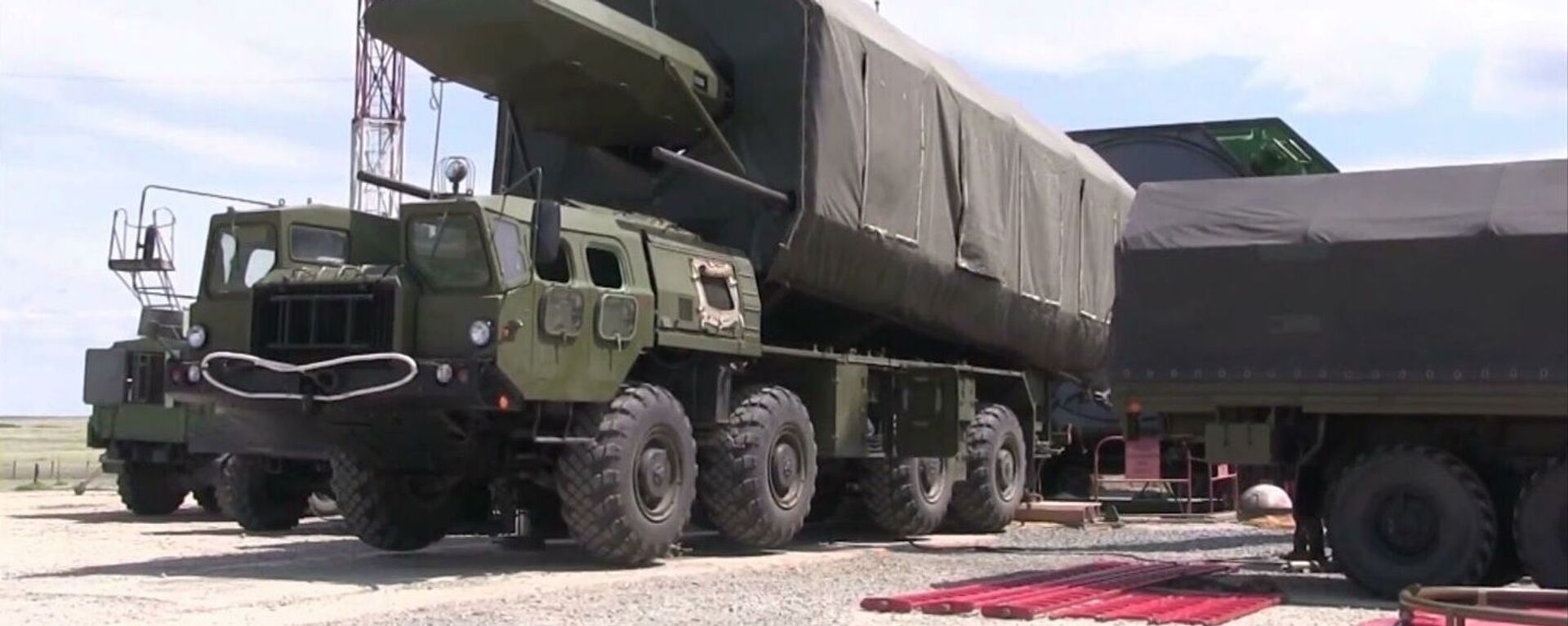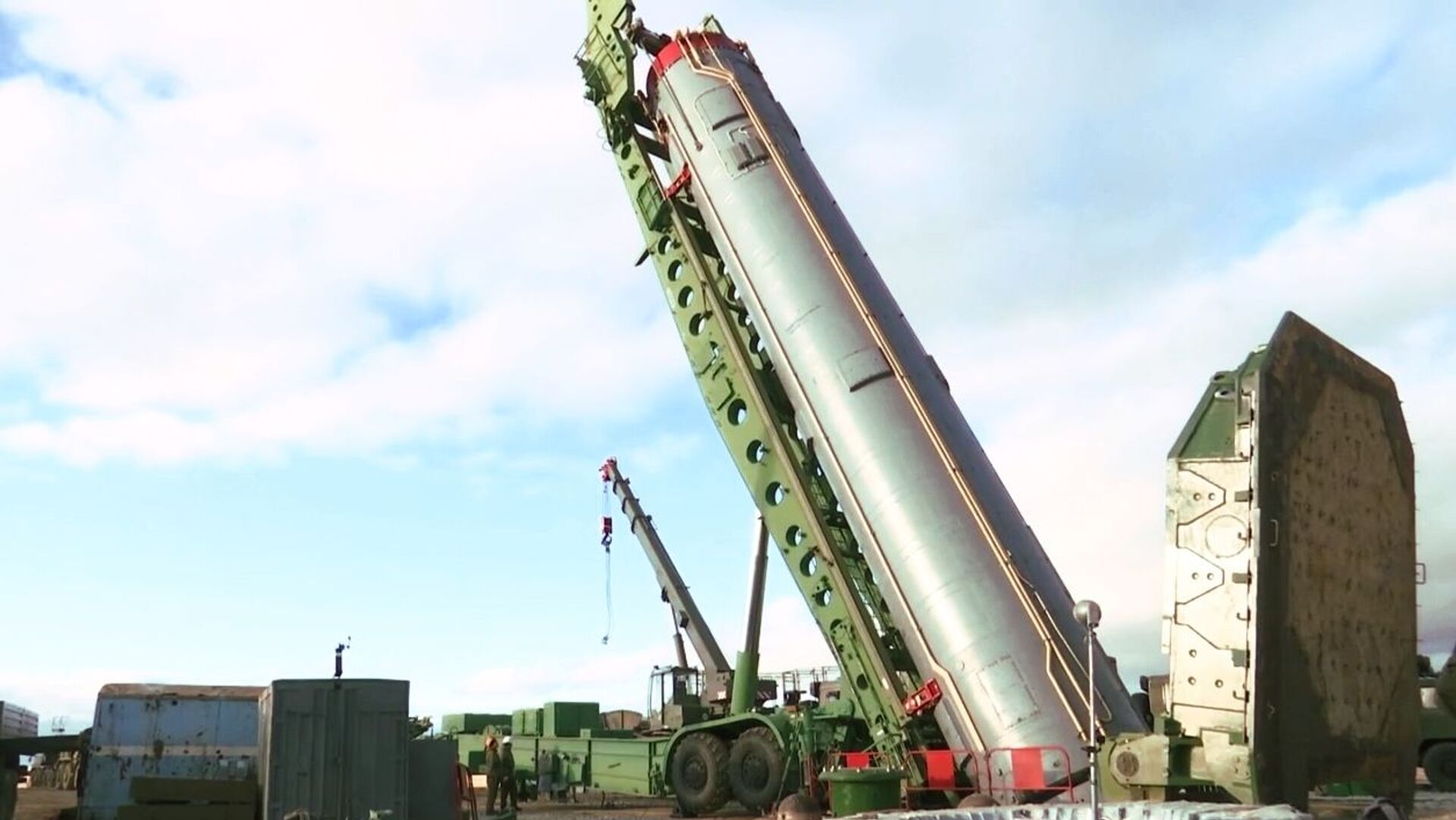https://sputnikglobe.com/20231020/how-fast-is-russias-avangard-missile-1114346196.html
How Fast is Russia's Avangard Missile?
How Fast is Russia's Avangard Missile?
Sputnik International
In modern combat operations, speed (whether on land or in the air) is often the signature attribute between victory and defeat. The Avangard's unparalleled velocity allows it to hit targets with break-neck speed precisely. This capability dramatically lowers reaction time for adversaries and renders traditional defense measures far less effective.
2023-10-20T15:09+0000
2023-10-20T15:09+0000
2023-10-20T15:09+0000
military
russia
avangard
military & intelligence
dombarovsky
kura
russian defense ministry
ss
https://cdn1.img.sputnikglobe.com/img/07e5/07/06/1083321779_0:0:1256:707_1920x0_80_0_0_94cfe1c17386dac974117d786f69e937.jpg
The Avangard missile system is a testament to the rapid advancements in aerial warfare technology in recent years. Developed by Russia, this avant-garde weapon system represents a consequential leap forward in contemporary ballistic missiles.This missile is represented by its revolutionary hypersonic glide vehicle (HGV), which allows it to travel at unprecedented velocity, far surpassing conventional ballistic missiles. Furthermore, the Avangard HGV can carry several warheads, providing flexibility in its strategic application.Its rapid deployment and unmatched speed make it an invaluable asset in offensive and defensive military plans. The Avangard's ability to elude enemy defenses and deliver payloads with pinpoint accuracy has reshaped the strategic landscape, prompting nations worldwide to reassess their defense postures and invest heavily in countermeasures.Sputnik touches upon understanding the intricacies of the Avangard system and why it's pivotal in the evolving face of threats to Russia's national security.What's the Avangard Missile?Previously referred to as Project 4202, the Avangard is a traditional nuclear-capable, boost-glide vehicle that is transported into space as a multiple independently targetable reentry vehicle (MIRV) atop an existing intercontinental ballistic missile like the UR-100N UTTH or RS-18A (UR-100/SS-19 Stiletto), R-36M2, or RS-28 Sarmat. After being released, it enters suborbital space and glides down to the atmosphere's edge at meteoric velocity.Technical PropertiesIt's worth noting that technical characteristics of the Avangard missile system have not been officially published, so any relevant information can only be obtained through public data.The Avangard is often portrayed as a delta-shaped vehicle, enveloped in a glowing plasma shield. Measuring about 5.4 meters, or nearly 18 feet, the Avangard is a sizeable vehicle and weighs roughly 2,000 kg.According to media reports, the Avangard missile boasts an impressive maximum speed, ranging from 20 to 27 Mach (24,696 to 33,340 kilometers per hour) in dense layers of the atmosphere. This versatile system is designed to carry nuclear and conventional payloads. However, its potential blast yield figures is estimated to range between 150 kilotons to two megatons (trinitrotoluene - TNT equivalent). The Avangard's successful test marks a major milestone in materials science and heat control. Russian authorities say the novel weapon is protected by a unique composite material that endured temperatures between 1,600 to 2,000°C during intercontinental hypersonic flight for several minutes.Additionally, the Avangard incorporates advanced guidance systems, ensuring precise navigation and target acquisition during its high-speed flight.The Avangard's fuselage is engineered to reduce drag and maximize aerodynamic efficiency. This design feature, combined with its maneuvering capabilities, allows the missile to alter its trajectory mid-flight, evading potential interception attempts. The result is a weapon system that challenges existing missile defense paradigms and significantly reduces the response window for potential targets.Strategic Military Objectives of Avangard MissileThe Avangard missile's unprecedented speed and maneuverability have profound implications for the landscape of strategic warfare, reshaping the dynamics of offense, defense, and deterrence.According to Russian sources, the Avangard hypersonic boost-glide weapon is designed to eliminate missile defense installations and high-value targets like heavily fortified sites such as missile silos or military command centers. Implications of Avangard's Extreme Speed for WarfareAvangard's Combat Service History
https://sputnikglobe.com/20191227/russias-avangard-hypersonic-missile-system-has-entered-into-service-what-we-know-so-far-1077881843.html
https://sputnikglobe.com/20200912/russias-avangard-glide-vehicle-more-deterrent-weapon-than-nuclear-bomb-chinese-media-claims-1080441568.html
https://sputnikglobe.com/20190724/russias-avangard-hypersonic-glide-vehicle-not-violating-new-start-deal-1076345417.html
russia
dombarovsky
kura
Sputnik International
feedback@sputniknews.com
+74956456601
MIA „Rossiya Segodnya“
2023
Chimauchem Nwosu
https://cdn1.img.sputnikglobe.com/img/07e7/09/01/1113046371_0:99:1536:1635_100x100_80_0_0_9c5c627283eca931c39fe4852bbb301c.jpg
Chimauchem Nwosu
https://cdn1.img.sputnikglobe.com/img/07e7/09/01/1113046371_0:99:1536:1635_100x100_80_0_0_9c5c627283eca931c39fe4852bbb301c.jpg
News
en_EN
Sputnik International
feedback@sputniknews.com
+74956456601
MIA „Rossiya Segodnya“
Sputnik International
feedback@sputniknews.com
+74956456601
MIA „Rossiya Segodnya“
Chimauchem Nwosu
https://cdn1.img.sputnikglobe.com/img/07e7/09/01/1113046371_0:99:1536:1635_100x100_80_0_0_9c5c627283eca931c39fe4852bbb301c.jpg
avangard missile system, avangard aerial warfare technology, ballistic missiles, hypersonic glide vehicle, avangard boost-glide vehicle, mirv, intercontinental ballistic missile, ur-100n utth, rs-18a, ur-100/ss-19 stiletto, r-36m2, rs-28 sarmat, delta-shaped vehicle, plasma shield, avangard maximum speed, mach, avangard blast yield, missile defense, missile defense installations, missile silos, military command centers, avangard reaction time, avangard precision, avangard combat service, avangard flight testing, avangard glide vehicle test, serial production, new start treaty, active service, missile regiment, combat duty, hypersonic missile system, russian strategic missile forces, orenburg region, avangard, russia, project 4202, ur-100uttkh, dombarovsky air base, orenburg oblast, kura missile test range, kamchatka krai, federal assembly, moscow, us inspection group, yasnenskoye missile formation.
avangard missile system, avangard aerial warfare technology, ballistic missiles, hypersonic glide vehicle, avangard boost-glide vehicle, mirv, intercontinental ballistic missile, ur-100n utth, rs-18a, ur-100/ss-19 stiletto, r-36m2, rs-28 sarmat, delta-shaped vehicle, plasma shield, avangard maximum speed, mach, avangard blast yield, missile defense, missile defense installations, missile silos, military command centers, avangard reaction time, avangard precision, avangard combat service, avangard flight testing, avangard glide vehicle test, serial production, new start treaty, active service, missile regiment, combat duty, hypersonic missile system, russian strategic missile forces, orenburg region, avangard, russia, project 4202, ur-100uttkh, dombarovsky air base, orenburg oblast, kura missile test range, kamchatka krai, federal assembly, moscow, us inspection group, yasnenskoye missile formation.
How Fast is Russia's Avangard Missile?
In modern combat operations, speed (whether on land or in the air) is often the signature attribute between victory and defeat. The Avangard's unparalleled velocity allows it to hit targets with break-neck speed precisely. This capability dramatically lowers reaction time for adversaries and renders traditional defense measures far less effective.
The
Avangard missile system is a testament to the rapid advancements in aerial warfare technology in recent years. Developed by Russia, this avant-garde weapon system represents a consequential leap forward in contemporary ballistic missiles.
This missile is represented by its revolutionary
hypersonic glide vehicle (HGV), which allows it to travel at unprecedented velocity, far surpassing conventional ballistic missiles.
Furthermore, the Avangard HGV can carry several warheads, providing flexibility in its strategic application.
Its rapid deployment and unmatched speed make it an invaluable asset in offensive and defensive military plans. The Avangard's ability to elude enemy defenses and deliver payloads with pinpoint accuracy has reshaped the strategic landscape, prompting nations worldwide to reassess their defense postures and invest heavily in countermeasures.
Sputnik touches upon understanding the intricacies of the Avangard system and why it's pivotal in the evolving face of threats to Russia's national security.

27 December 2019, 13:31 GMT
What's the Avangard Missile?
Previously referred to as Project 4202, the Avangard is a traditional nuclear-capable, boost-glide vehicle that is transported into space as a multiple independently targetable reentry vehicle (MIRV) atop an existing intercontinental ballistic missile like the UR-100N UTTH or RS-18A (UR-100/SS-19 Stiletto), R-36M2, or RS-28 Sarmat. After being released, it enters suborbital space and glides down to the atmosphere's edge at meteoric velocity.
It's worth noting that technical characteristics of the Avangard missile system have not been officially published, so any relevant information can only be obtained through public data.
The Avangard is often portrayed as a delta-shaped vehicle, enveloped in a glowing plasma shield. Measuring about 5.4 meters, or nearly 18 feet, the Avangard is a sizeable vehicle and weighs roughly 2,000 kg.
According to media reports, the Avangard missile boasts an impressive maximum speed, ranging from 20 to 27 Mach (24,696 to 33,340 kilometers per hour) in dense layers of the atmosphere. This versatile system is designed to carry nuclear and conventional payloads. However, its potential blast yield figures is estimated to range between 150 kilotons to two megatons (trinitrotoluene - TNT equivalent).
The Avangard's successful test marks a major milestone in materials science and heat control. Russian authorities say the novel weapon is protected by a unique composite material that endured temperatures between 1,600 to 2,000°C during intercontinental hypersonic flight for several minutes.
Additionally, the Avangard incorporates advanced guidance systems, ensuring precise navigation and target acquisition during its high-speed flight.
The Avangard's fuselage is engineered to reduce drag and maximize aerodynamic efficiency. This design feature, combined with its maneuvering capabilities, allows the missile to alter its trajectory mid-flight, evading potential interception attempts. The result is a weapon system that challenges existing missile defense paradigms and significantly reduces the response window for potential targets.
Strategic Military Objectives of Avangard Missile
The Avangard missile's unprecedented speed and maneuverability have profound implications for the landscape of strategic warfare, reshaping the dynamics of offense, defense, and deterrence.

12 September 2020, 16:10 GMT
According to Russian sources, the Avangard hypersonic boost-glide weapon is designed to eliminate missile defense installations and high-value targets like heavily fortified sites such as missile silos or military command centers.
Implications of Avangard's Extreme Speed for Warfare
Reduced Reaction Time: The Avangard's extraordinary speed drastically shortens the response window for potential targets. Adversaries have significantly less time to detect, assess, and formulate a counter-strategy. This increases the element of surprise and diminishes the effectiveness of conventional defense measures.
Enhanced Precision: The Avangard's ability to maintain high speeds while making course adjustments ensures exceptional precision in striking targets. This level of accuracy is crucial in strategic warfare, particularly when targeting heavily fortified or time-sensitive objectives.
Evasion of Defenses: As it moves towards a target, the Avangard performs deep maneuvering, both lateral and vertical, rendering it invulnerable to missile defense and air defense systems. Unlike predictable ballistic trajectories, the Avangard's mid-flight course alterations make it exceptionally difficult to intercept. This challenges existing missile defense paradigms and necessitates the development of more sophisticated and adaptable countermeasures.
Strategic Flexibility: The Avangard's high speed and maneuverability enable it to engage various targets, including moving naval vessels or time-critical, high-value assets. This versatility enhances its effectiveness in a wide range of strategic scenarios.
Avangard's Combat Service History
From February 2015 to June 2016, the Avangard, a highly advanced weapon, underwent flight testing. It was launched using UR-100UTTKh ICBMs from Dombarovsky Air Base in Orenburg Oblast. The Avangard demonstrated remarkable speed and precision during these tests by successfully hitting targets at the Kura Missile Test Range in Kamchatka Krai.
October 2016 saw the successful flight test of a R-36M2 heavy ICBM launched from Dombarovsky Air Base. It hit its target at the Kura Missile Test Range, marking the first successful glide vehicle test.
On March 1, 2018, Russian President Vladimir Putin revealed in his address to the Federal Assembly in Moscow that the weapon had completed its testing phase and was officially in serial production.






